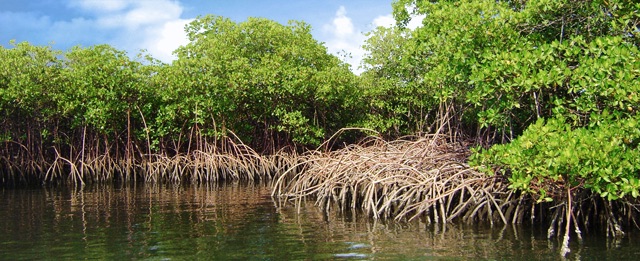78 11.6 Mangrove Ecosystems

Mangrove Ecosystems
Mangrove swamps are a complex and diverse compilation of resilient species that tolerate extremely challenging conditions of living in shallow seawater. There are approximately 70 species of mangrove trees that act as the foundation of the ecosystem, providing a habitat for numerous species in their branches above water and their tangled roots below water. Mangrove trees have adapted to living in high salinity conditions by developing a filtration system in their roots, and to stabilizing the soft sediments below by creating a complex root matrix to support their often massive weight above water. Many species of birds nest, roost, and feed in the canopy of the Mangroves. Various insects, snakes, lizards, and frogs make their homes in the branches, as well. Much like a coral reef or rocky intertidal shore, mangroves also provide habitat for many invertebrate and vertebrate marine species. Crabs, anemones, mussels, barnacles, oysters, and even juvenile reef fishes can be found clinging to or swimming through the complex system of roots. The mangrove provides shelter from predators as well as protection from physical forces such as high velocities of water flow for these small critters. It is important to protect this unique type of ecosystem because it provides shelter to an incredible diversity of marine and terrestrial species.
Mangroves provide billions of dollars worth of free services to humans. Through photosynthesis, they absorb a large chunk of carbon dioxide from the atmosphere, helping to reduce green house gas effects. They filter waste water and pollution along developed coastlines and provide clean water for numerous marine species. Additionally, their sturdy root system stabilizes shores from erosion or strong storms and can even create new land by trapping sediments. Mangroves also provide direct benefits to humans in the forms of medicines, seafood, fruits, fiber, and wood. However, in the past decade alone, over 35% of the world’s mangroves have been destroyed largely due to human activity. Coastal development, climate change, and aquaculture have removed mangroves at an alarming rate that is more rapid than deforestation of tropical rainforests, yet have received far less attention from activists and media. Scientists estimate that all mangroves could be lost within the next 100 years if conservation efforts are not made. The loss of mangroves would cause a collapse of balance in many other ecosystems, especially coral reefs. Juvenile coral reef fish are raised within the mangrove root system, and without the mangroves, coral reef diversity will be adversely affected. Mangrove conservation should be one of the priorities of marine science in the near future.
By Hill et al. (University of California, Davis), used under a CC-BY-NC-SA 4.0 international license. Download this book for free at https://geo.libretexts.org/Bookshelves/Oceanography/Book%3A_Oceanography_(Hill)

